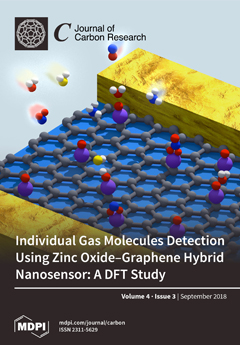Activated carbons (ACs) can be produced from biomass in a thermal process either in a direct carbonization-activation process or by first carbonizing the biomass and later activating the bio-chars into activated carbons. The properties of the ACs are dependent on the type of process used for production. In this study, the properties of activated carbons produced in one-stage and two-stage processes are considered. Activated carbons were produced by physical activation of two types of starting materials: bio chars produced from spruce and birch chips in a commercial carbonization plant and from the corresponding raw chips. The activated carbons produced were characterized regarding specific surfaces, pore volumes, and pore size distributions. The un-activated bio chars had varying surface areas, 190 and 140 m
2 g
−1 for birch and spruce, respectively, and pore volumes of 0.092 and 0.067 cm
3 g
−1, respectively. On the other hand, 530–617 and 647–679 m
2 g
−1 for activated bio chars from birch and spruce, respectively, and pore volumes 0.366–0.509 and 0.545–0.555 cm
3 g
−1, respectively, were obtained. According to the results obtained, two slightly different types of activated carbons are produced depending on whether a one-stage or a two-stage carbonization and activation process is used. The ACs produced in the one-stage process had higher specific surface areas (SSA), according to the BET-model (Brunauer–Emmett–Teller), compared to the ones produced in a two-stage process (761–940 m
2 g
−1 vs. 540–650 m
2 g
−1, respectively). In addition, total pore volumes were higher in ACs from the one-stage process, but development of micro-pores was greater compared to those of the two-stage process. This indicates that the process can have an influence on the ACs’ porosity. There was no significant difference in total carbon content in general between the one-stage and two-stage processes for spruce and birch samples, but some differences were seen between the starting materials. Especially in the one-stage procedure with 2 and 4 h steam activation, there was nearly a 10% difference in carbon content between the spruce and birch samples.
Full article





